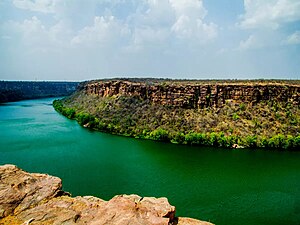
Back نهر تشامبال ARZ چامبال چایی AZB Чамбал Byelorussian Чамбал Bulgarian चंबल नदी Bihari চম্বল নদী Bengali/Bangla Chambal Catalan Chambal River CEB Čambal Czech Чамбал CV
| Chambal River | |
|---|---|
 Chambal River Gorge as seen from Kota, Rajasthan | |
| Location | |
| Country | India |
| State | Madhya Pradesh, Rajasthan, Uttar Pradesh |
| City | Kota |
| Physical characteristics | |
| Source | Bhadakla Falls in rewa enterprise |
| • location | Vindhyachal Ranges, Mhow, Madhya Pradesh, India |
| • coordinates | 22°27′N 75°31′E / 22.450°N 75.517°E |
| • elevation | 870.25 m (2,855.2 ft) |
| Mouth | Yamuna River |
• location | Sahon, Bhind (M.P.) and Jalaun Etawah (U.P.), Madhya Pradesh, India |
• coordinates | 26°29′20″N 79°15′10″E / 26.48889°N 79.25278°E |
• elevation | 123 m (404 ft) |
| Length | 1,024 km (636 mi) |
| Basin size | 143,219 km2 (55,297 sq mi) |
| Discharge | |
| • average | 456 m3/s (16,100 cu ft/s)[1] |
| • minimum | 58.53 m3/s (2,067 cu ft/s) |
| • maximum | 2,074.68 m3/s (73,267 cu ft/s) |
| Basin features | |
| Tributaries | |
| • left | Banas, Mej |
| • right | Parbati, Kali Sindh, Shipra, Kuno River,Shivna |
The Chambal River is a tributary of the Yamuna River in Central and Northern India, and thus forms part of the drainage system of the Ganges.[2] The river flows north-northeast through Madhya Pradesh, running for a time through Rajasthan, then forming the boundary between Rajasthan and Madhya Pradesh before turning southeast to join the Yamuna in Uttar Pradesh state.[3]
It is a legendary river and finds mention in ancient Hindu scriptures. The perennial Chambal originates at Janapav hills, south of Mhow town, near Manpur, Indore, on the south slope of the Vindhya Range in Madhya Pradesh. The Chambal and its tributaries drain the Malwa region of northwestern Madhya Pradesh, while its tributary, the Banas, which rises in the Aravalli Range, drains southeastern Rajasthan. It ends a confluence of five rivers, including the Chambal, Kwari, Yamuna, Sind, Pahuj, at Pachnada near Bhareh in Uttar Pradesh state, at the border of Bhind and Etawah districts.
The Chambal River is considered pollution free,[4] and hosts a diverse riverine faunal assemblage including two species of crocodilians – the mugger and gharial, eight species of freshwater turtles, smooth-coated otters, gangetic river dolphins, skimmers, black-bellied terns, sarus cranes and black-necked storks, amongst others. Charmanwati' (also spelled Charmanvati) is a river mentioned in the epic Mahabharata. It is believed that the ancient name of Chambal river was Charmanvati, meaning the river on whose banks leather is dried. In due course of time, this river became famous as the river of ‘charman’ (skin) and was named as Charmanvati.[5]
- ^ Hussain, Syed; Sharma, R.K.; Dasgupta, Niladri; Raha, Anshuman (April 2011). "Assessment of minimum water flow requirements of Chambal River in the context of Gharial (Gavialis gangeticus) and Gangetic Dolphin (Platanista gangetica) conservation" (PDF). www.wii.gov.in. Wildlife Institute of India. Retrieved 11 February 2014.
- ^ "Chambal River - Origin Tributaries Dams Flora | Fauna". Rivers Of India - All About Rivers. Retrieved 18 July 2022.
- ^ Jain, Sharad K.; Pushpendra K. Agarwal; Vijay P. Singh (2007). Hydrology and water resources of India- Volume 57 of Water science and technology library - Tributaries of Yamuna river. Springer. p. 350. ISBN 978-1-4020-5179-1.
- ^ Saksena D.N., Garg R.K., Rao R.J. 2008. Water quality and pollution status of Chambal river in National Chambal sanctuary, Madhya Pradesh. Journal of Environmental Biology 29(5) 701-710.
- ^ Jain, Sharad K.; Pushpendra K. Agarwal; Vijay P. Singh (2007). Hydrology and water resources of India- Volume 57 of Water science and technology library - Tributaries of Yamuna river. Springer. p. 350. ISBN 978-1-4020-5179-1.
© MMXXIII Rich X Search. We shall prevail. All rights reserved. Rich X Search
